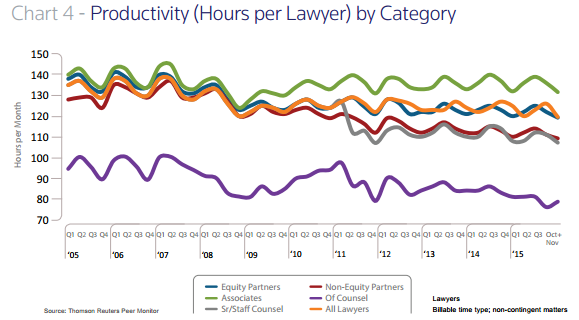Did Firms Raise Salaries High Enough?
Originally published on Above The Law.
 Deborah Merritt, a law professor at the Ohio State University, published an informative analysis on her blog yesterday about the new market rate salary for large law firms, which has been extensively covered here on ATL.
Deborah Merritt, a law professor at the Ohio State University, published an informative analysis on her blog yesterday about the new market rate salary for large law firms, which has been extensively covered here on ATL.
To her and virtually every other observer, the increase to $180,000 signals that many large firms are prospering. In part the increase reflects a small but steady increase in associate productivity since 2008, reaching roughly the levels from the last market rate increase in 2007. The following chart is from the 2016 Report on the State of the Legal Market, issued by Georgetown Law’s Center for the Study of the Legal Profession:

Associates are continuously more productive by this measure than any other category of worker, although at lower billable rates than partners. Interestingly, the gap in productivity between associates and other groups is significantly greater post-recession.
What’s most interesting, however, is the comparison between total salary expenditures in 2008 versus 2015. According to Professor Merritt’s calculations, large law firms are spending between $200 and $300 million less on associates than they were in 2008 — and this accounts for the latest salary increase.
She uses the number of new graduates at firms with 500 or more lawyers as a proxy for the number of graduates obtaining jobs paying market rate. In 2008, that number was 5,193. In 2015, it was 4,008. Professor Merritt points out that entry-level hiring has changed at the largest law firms, so these numbers are not directly comparable.
But after 2008, firms began bifurcating their entry-level hiring. They continued to hire new associates at top salaries, but they also retained staff attorneys at much lower salaries. Orrick began employing “career associates” at a Wheeling, West Virginia, office in 2009. WilmerHale followed with a Dayton, Ohio, office for staff attorneys in 2010.
Based on data from NALP about 2014 graduates, she believes the number of new associates who just got or are about to get their pay bumped is between 3,500 and 4,000.
I’ve taken her figures and put it into the following table:
| Year | Salary | # of Positions | Nominal Dollars | 2015 Constant Dollars |
| 2008 | $160,000 | 5,193 | $831 million | $915 million |
| 2015 | $180,000 | 3,500 | $630 million | – |
| 2015 | $180,000 | 4,000 | $720 million | – |
I use different assumptions, but come to a similar conclusion. I start with the number of graduates at firms with more than 500 attorneys. I reduce that by a small percentage (5%) to account for the firms that did not pay associates New York market. I then add the number of graduates at firms with more than 250 attorneys, but only after reducing that number by a larger percentage (40%) to account for the non-market paying firms. The result is an estimate of 5,950 in 2008 and 5,038 in 2015, a 15% decline in headcount.
My table looks like this:
| Year | Salary | # of Positions | Nominal Dollars | 2015 Constant Dollars |
| 2008 | $160,000 | 5,950 | $952 million | $1.05 billion |
| 2015 | $180,000 | 4,200 | $755 million | – |
| 2015 | $180,000 | 5,000 | $900 million | – |
As Professor Merritt did, I gave a range in 2015 to account for the compositional change in 2015. The total amount spent on associate salaries (using my assumptions) reduced by between $105 million and $250 million.
However — and Professor Merritt acknowledges this in her post — firms are spending some of those savings on non-associate attorneys. Overhead, including health insurance, likely increased at firms too. Moreover, neither analysis looks at bonuses.
Most importantly, we have little idea whether the remaining savings went to partners or to reducing prices for clients. Certainly that varies. What we can be sure of is that the changes in spending and base salaries were expected. On that I will give Professor Merritt the final word:
Indeed, the pattern we are now seeing — higher salaries for a smaller number of elite lawyers — is exactly what we would expect in a market characterized by disaggregation, globalization, and technological gains. Those forces make individual lawyers more productive, which allows salary increases. The same trends, however, decrease the number of new lawyers needed to do the same work. The impact is particularly acute at the top of the any work chain, because those lawyers incorporate the productivity gains of the lawyers beneath them.
About Law School Cafe
Cafe Manager & Co-Moderator
Deborah J. Merritt
Cafe Designer & Co-Moderator
Kyle McEntee
 Law School Cafe is a resource for anyone interested in changes in legal education and the legal profession.
Law School Cafe is a resource for anyone interested in changes in legal education and the legal profession.
Around the Cafe
Subscribe
Categories
Recent Comments
- on Scholarship Advice
- on ExamSoft: New Evidence from NCBE
- on COVID-19 and the Bar Exam
- on Women Law Students: Still Not Equal
- on Ranking Academic Impact
Recent Posts
- The Bot Takes a Bow
- Fundamental Legal Concepts and Principles
- Lay Down the Law
- The Bot Updates the Bar Exam
- GPT-4 Beats the Bar Exam
Monthly Archives
Participate
Have something you think our audience would like to hear about? Interested in writing one or more guest posts? Send an email to the cafe manager at merritt52@gmail.com. We are interested in publishing posts from practitioners, students, faculty, and industry professionals.